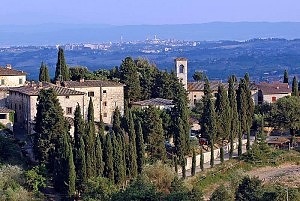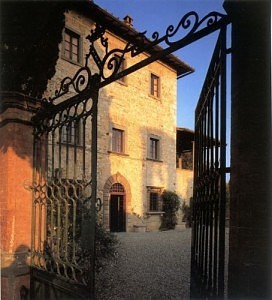It all started in Fonterutoli 10 Novembre 2010 – Posted in: . ENGLISH TEXT
 “I hereby give, on December 6 (1398), fiorini 3, soldi 26 denari 8 to Piero Tino Riccio, for 6 barrels of Chianti wine;… we pay the money by letter of Ser Lapo Mazzei.”
“I hereby give, on December 6 (1398), fiorini 3, soldi 26 denari 8 to Piero Tino Riccio, for 6 barrels of Chianti wine;… we pay the money by letter of Ser Lapo Mazzei.”
At the end of the fourteenth Century, a respected and influential member of the Mazzei family, Ser Lapo, notary of the Lordship of Florence, a fine speculative mind and a major expert of vineyards, bought Chianti wines. Later on it was his niece’s fate, Madonna Smeralda, to marry Piero di Agnolo da Fonterutoli. She had as an endowment the properties of her husband and starting from then the Mazzei family, which had been producing wine in Carmignano, their country of origin, for a long time, no longer needed to buy Chianti.
 After many centuries the Mazzei family is still here, in Fonterutoli, the ancient Fons Rutolae, that used to be a resting place for travellers before the year one thousand and later a Florentine castle during the long dispute between Florence and Siena. The members of the family are proud entrepreneurs in the hamlet, located near Castellina in Chianti, and they are sustained by the pride of being keepers of past memories of the history of Florence and Chianti.
After many centuries the Mazzei family is still here, in Fonterutoli, the ancient Fons Rutolae, that used to be a resting place for travellers before the year one thousand and later a Florentine castle during the long dispute between Florence and Siena. The members of the family are proud entrepreneurs in the hamlet, located near Castellina in Chianti, and they are sustained by the pride of being keepers of past memories of the history of Florence and Chianti.
The medieval buildings were destroyed several times by the attacks of the people of Siena, to the extent that the beautiful buildings that visitors enjoy today date back to the XV century and the following ones. Some of the houses of the sixteenth and seventeenth century, however, were built on the ruins of medieval complexes, and clearly show older areas of ancient walls that help the narration and the charm of the scenery.
Behind an iron gate there is a r ural and yet elegant villa owned by Marchesi Mazzei. The villa dates back to the same period and the beautiful raw-stones cover shows its rural soul.
ural and yet elegant villa owned by Marchesi Mazzei. The villa dates back to the same period and the beautiful raw-stones cover shows its rural soul.
The small village of Fonterutoli winds outside the estate, with its church, the stone houses and the kind and frugal people looking after their work. A suggestive conglomeration of stone buildings with small streets, partly cobbled, around a gentle slope that holds it and hides it. A small village that people did not change and where life is active but not frantic. The village is a model of life at a human pace that Chianti can still offer and protect.
